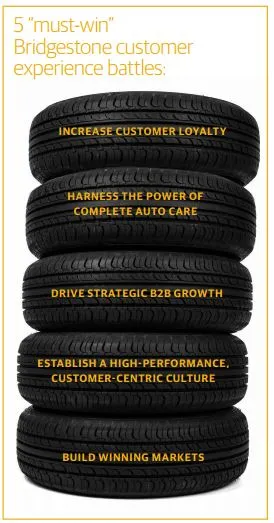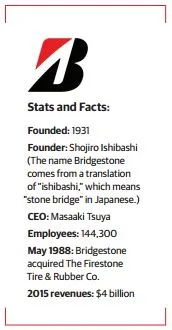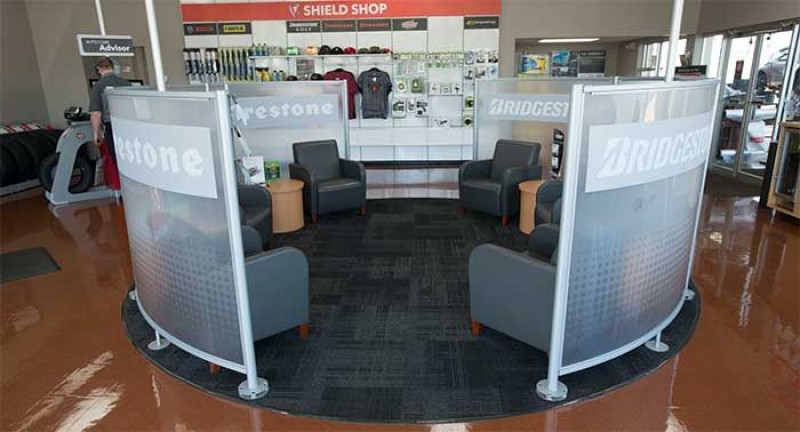Few drivers look forward to visiting an automotive shop. The experience is often time consuming and many people find themselves spending more than they expect. Bridgestone Retail Operations—which includes more than 2,200 tire and automotive service centers, such as Firestone Complete Auto Care, Tires Plus, Hibdon Tires Plus, and Wheel Works—hopes to change those perceptions by transforming its customer experience.
Stu Crum, president of Bridgestone Retail Operations, framed the initiative as “Vision 2020.” At a recent press event, Crum notes that “we’re not just competing with other auto care companies, we’re competing with [the customer experiences of] Nordstrom and Chick-fil-A…and so our goal is to be ranked with the most admired customer service companies by the end of the decade.”
Serving the Boss
To drive home the understanding that the customer is in charge, Bridgestone Americas, which includes Bridgestone Retail Operations, Firestone Building Products, and other divisions, refers to the customer as “the boss.” And keeping the boss happy is critical.
Noting that approximately 9 percent of Bridgestone Retail’s 34 million customers are responsible for 42 percent of the company’s revenue and 47 percent of profits, Crum stresses that the business must develop ways to attract new customers—and retain them.
Bridgestone Retail is reviewing the way it does business to move away from transactional business practices, says Jeffrey Lack, vice president of marketing and promotions. Instead of treating customers as one-time customers, the company wants to create “an environment where the boss is comfortable returning to a Bridgestone Retail store for all of his or her automotive maintenance needs,” Lack says.
To explore ways to promote customer loyalty, Bridgestone Retail created a “lab store” concept, where new customer interactions and auto service processes are tested and evaluated. There are seven lab stores across the U.S. in Alpharetta and Suwanee, Ga.; St. Charles and Woodfield, Ill.; Eden Prairie and Maplewood, Minn., and Antioch, Tenn.

During a tour of the St. Charles store, reporters examined some of the concepts that are currently being tested, which include:
Concierge service: Designated employees greet customers as they enter the store to find out what they need. The company already learned that it is better to wait for customers to enter the store rather than approach customers as soon as they park. Additionally, the concierges will eventually use hand-held tablets to help them speed up the process.
Virtual vehicle: A station where customers can watch educational videos on a screen while their vehicle is being serviced. The videos explain how the major systems in the car work, and how they can fail. The goal is for customers to have a better understanding of necessary repairs rather than feel that they’re being oversold on services.
Pods: Stand-alone pods that provide more privacy for the customer while completing his or her transaction.
Shield shops: A wall or corner of the customer area where Bridgestone displays Firestone-branded apparel or merchandise like branded golf balls and tee-shirts, as well as merchandise from its retail partners including Rain-X washer fluid, QMI automotive lubricants, and Interstate Batteries.
Circular customer waiting areas: Located in the middle of the store, these waiting areas are designed to emphasize the idea that the “boss” is central to business operations. Children in the waiting area are also given tablets pre-loaded with games to keep them occupied.
In the service area, Bridgestone Retail applies lean manufacturing principles to the auto care experience to provide fast and accurate services, according to George Kingman, Lab Stores area manager for the greater Chicago area. “Technicians are essentially vehicle doctors and they need to quickly identify the right diagnosis for a vehicle,” he says.
Among the new approaches that are being tested is a free multi-point vehicle inspection that would be offered to all customers, regardless of the nature of the visit. The inspection is conducted with a digital inspection platform that provides an alignment and tire check using a laser-based drive-over inspection system, tire pressure check, car battery check, and fluid level check. Interior vacuuming and floor mat cleaning would also be included.
The benefit of automating the inspection process is that it reduces the inspection to as little as two to three minutes. And with the right “choreography” of services, an oil change that typically takes 45 minutes can be completed in 15 minutes, Kingman says. However, the speed at which services are carried out must be aligned with customer expectations.
“What we’ve learned is that if we service the car too quickly, the customer wonders if we cut corners and if the job was done correctly,” Kingman says. “And so before we roll out these processes to all our locations, we need to make sure that we’ve choreographed everything to match the boss’s expectations.”
Bridgestone is also working to capture and store all the inspection data digitally. Bridgestone already has a CRM system that receives daily feeds from several other databases, including transactional records and boss profile information. But there are still opportunities to build a more robust CRM system. For example, records of each customer’s visits eventually will be accessible by any Bridgestone Retail store, should that customer visit another store.
Furthermore, by aggregating and analyzing this data, the organization can predict when a vehicle will be due for service again. That would then trigger emails to remind bosses that it’s time for another visit. The innovations appear to be working. In the past year, customer satisfaction at the St. Charles store rose from 87 to 96.
Some of the findings from the consumer lab store are also being applied to Bridgestone’s B2B business. Bridgestone’s B2B customers include its fleet customers—service companies, rental car companies, etc. “For the B2B customer, their vehicle is their mobile office, so reducing down time is critical,” says Amy Bonder, vice president of sales and strategy. The company is developing services including a dedicated service bay for fleet vehicles to increase efficiency. It is also making simple modifications, like a separate entrance and separate waiting area where B2B drivers can plug in and work while their vehicle is serviced.
An eye on growth
Bridgestone’s Vision for 2020 includes expanding its footprint. The organization plans to add about 800 more stores to its stable of 2,200-plus company-owned retail stores.
To reach its goal, Bridgestone Retail expects to open roughly 45 new retail locations each year over the coming years. It’s also looking to also acquire other companies, Crum says, with some deals to be announced by the end of 2016. Combined with the acquisition deals, the company’s footprint could reach as many as 3,500 stores.
This strategy originally included purchasing a competitor—Pep Boys—but Bridgestone reportedly backed away from that deal late last year after the bidding with rival Icahn Enterprises L.P. exceeded $1 billion. At that time, Pep Boys operated more than 800 retail locations with 7,500-plus service bays in 35 states and Puerto Rico, generating annual sales of more than $2 billion. By comparison, the Bridgestone Retail business unit was generating about $4 billion worth of sales.
And prior to submitting its initial bid last October for Pep Boys, Bridgestone had established a budget of about $800 million to cover the growth strategy that had been laid out. That budget is still in place, Crum says, and it will be used for other acquisition deals, as well as to build new stores and renovate existing stores.

Hiring and training more employees at the additional stores will also be critical, Crum says. Bridgestone Retail currently employs about 23,000 workers. The company has not said exactly how many new employees it will hire but it plans to recruit a “significant” number, he says.
The company is about two years into its initiative. Through 2017, Bridgestone Retail is in the “acceleration” stage. It will invest in the design and testing of its new customer experiences, optimizing the service delivery and operating models, and ramping up new store openings. By 2018, the company expects to be in the growth stage, where it will begin leveraging some of its innovations to deliver a more personalized customer experience and expand its retail footprint.
At the same time, Crum acknowledges that improving the customer experience is a never-ending process. “Trust is a very big issue in our industry,” he says. “People dread bringing their car in because they’re afraid of it taking too long or upselling. And earning that trust takes time and continuous dedication to connecting with the customer and meeting their needs.”















